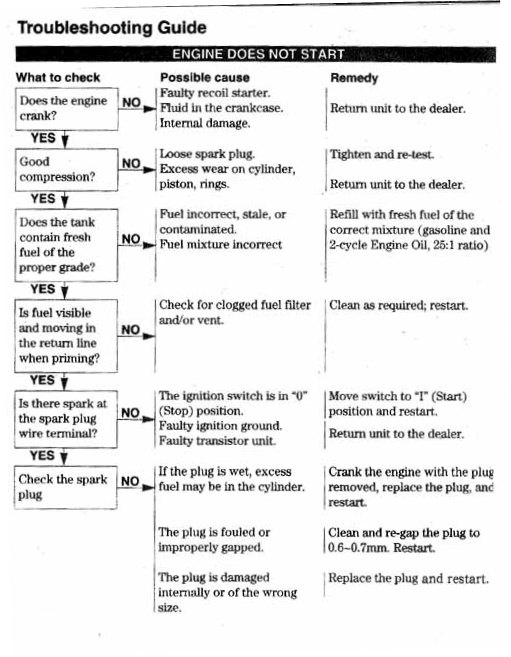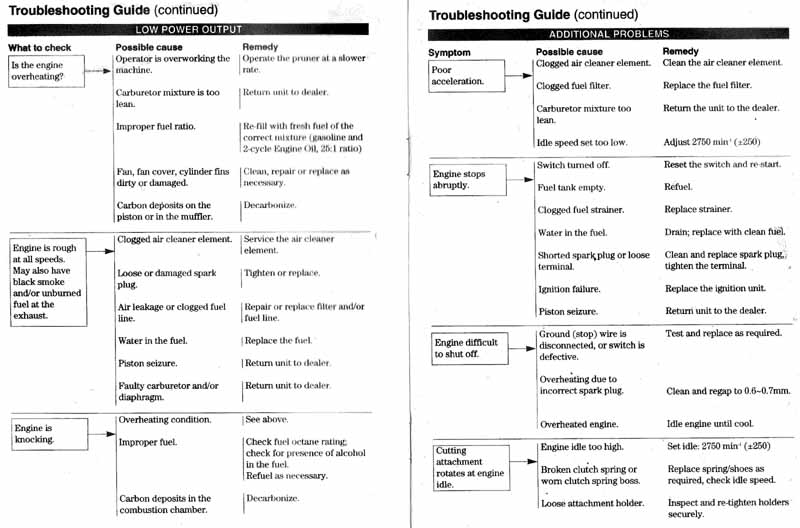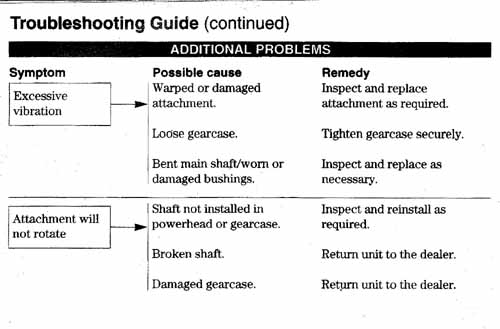

READ THIS FIRST Box Contents Tips Trouble Shoot Chart Specifications Main Site
Support - Power Auger
Expanded Instruction Manuals, Tips, Troubleshooting
This page is at http://multipowertools.com/support/auger/auger.htm
|
Click here for PDF of the YardShape™ Power Auger Manual Includes details, pictures, parts and specifications |
1) Power Unit Box: power head and transmission, mixing bottle to mix gas with 2-stroke oil (1:25 or 1 part oil for 25 parts gas), tool set, manual
2) Large Auger Box: 10" Auger bit
3) Small Auger Box: 6" Auger bit
Pre-Use Assembly/Prep required:
1) Check that fuel supply tubes from tank are pushed on carburetor intakes. Black is on barbed nozzle on inside towards engine. Clear is on outside
2) Attach desired auger bit to power head unit using supplied pin and cotter pin. (2 minutes)
3) The transmission already has oil. The oil should be changed about every 30 hrs of use. Oil is just standard 10w-30 or similar multipurpose oil.
4) Check that all screws and bolts are tightened firmly.
1) Starting and Running. Check that fuel supply tubes from tank are pushed on barbed carburetor intakes (black on engine side). Make sure to turn on the cut-out switch prior to trying to start. Prime the carburetor by pumping the pump ball on base of carburetor until gas can be seen pumping through. Also choke lever must be up to choke. Push choke lever down towards tank to turn off choke and run normally. Make sure that your throttle cable is seated properly at the carburetor assembly. If your unit is not starting easily, does not start, or cuts out during operation, it is most likely caused by a fouled spark plug - even if the plug looks good or has only been run for a short time. The unit is designed to run optimally at FULL throttle all the time with a 1:25 mixture and you will not burn off the oil on the plug if you always run at low throttle. Get a new plug (BM6A) and reduce the amount of 2-stroke oil you are mixing with gas to something like 1:35-40.
To prolong the life of the pull unit (recoil starter), try to pull out handle until chord slack is eliminated and there is pull tension on the chord, before you make long pull. Also try to make shorter pulls rather than long pulls that pull chord out fully to stopper.
2) Metric sizes. All the bolts and heads in the unit are METRIC. You can do most things with the tools that come with the unit.
3) Gas Caps. The gas caps are vented. You may get some gas bubbles here but it should not leak. It is not necessary to over tighten the cap. Just make sure it is closed all the way and then give another 1/4 turn. Because the threads are so large, it is possible to incorrectly tighten it without actually having it threaded properly. If the cap is leaking, undo and try and re-thread it again. Also make sure that there is no debris on the gasket and that the cap is not on too tight (over-tightening can cause the cap to distort. You can also pry out the gasket and flip it over.
4) Auger bits. The included auger bits are about 33" and accept a 3/4" drive shaft. The machine is capable of digging into many different materials depending on the auger bits used. The included bits are designed to drill into dirt/clay etc. The bits also have a special twin-cut flange for easier starting and faster cutting.
5) Oil Filler Plugs. There is an oil filler plug on the top of the transmission and there is a smaller oil level/drain plug on the side. You can drain out of smaller side plug. Some of the top filler plugs have a reverse thread screw vent to help the oil to drain from side without removing top plug. Vent is opened by turning screw counterclockwise (it will screw in). Turn screw clockwise to raise and close vent (position for normal operation). To fill oil, remove top plug and fill oil in top hole until oil comes out the side filler plug hole, then stop filling and plug.
Specifications
- Check for disconnected fuel lines (see assembly above)
- Check for loose nuts/screws. Some units have shipped with some surface bolts that are not fully tightened. Just check to make sure that your bolts/screws are firmly tightened.
1) Unit does not start. Check the following (and also see the Trouble Shooting Chart at bottom of this page) :
1) Is the
choke lever on the side of the air filter cover pushed up away from tank for a
cold start?
2) Did you prime the carburetor by pumping the primer ball at bottom of
carburetor until the carburetor primer bulb is firm?
3) Did you check the stop switch in not in off position?
4) Do you have enough gas in the tank?
5) Do you have a good spark plug? A new plug is just a few dollars at a Home
Depot or similar (NGK BM6A equivalent), and may save a lot of time. With 2 cycle
engines, the oil in the mix will build up on the plug - especially if you unit
sits between uses. it can happen in a short amount of time. Even if your used
plug shows a spark, is recent, or has been cleaned, we would suggest having a
new one on hand to eliminate the plug as the problem. If you want to check the
spark ignition system, remove the plug from engine, connect the plug wire to the
plug and ground the side of plug to metal engine housing using pliers with
plastic grip handles so you don't get a shock. Pull the starter cord and watch
the plug for a spark jump. The spark should be bright blue and easy to see. If
you have a weak spark then the ignition system is working but that does not
necessarily mean that your plug is good. You may need a new plug.
6) If you have all above working, last area may be mix screw out of adjustment. You can try and fix this by adjusting the carburetor fuel mixture screw (the one with spring). Try undoing the screw to open up the inlet (richer mixture) and allow more gas to blow through. If it starts, even just for a short time, move the screw a little bit and see if the different position helps. Once it is running you can turn the screw clockwise for a leaner mixture until you get better rpms at full throttle.


